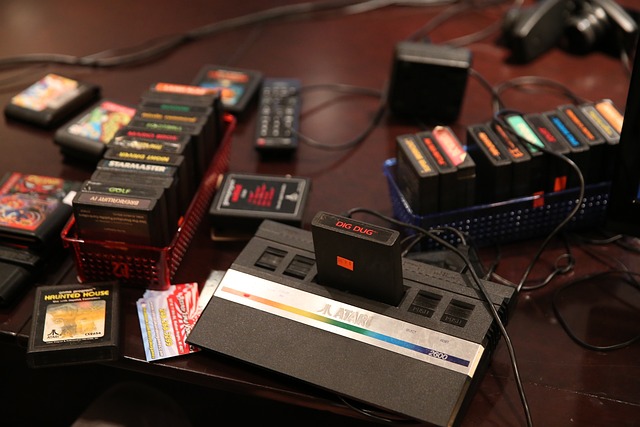History of early personal computers and gaming consoles
Published:
 In the 1970s and 1980s, the personal computer and gaming industries experienced a period of rapid growth and innovation, as new technologies and designs emerged to meet the demands of a growing market. Among the most popular and influential systems of this era were the Apple II, Atari 400 and Atari 800, Atari VCS (6507), BBC Micro, Commodore PET and VIC-20, Commodore 64 (6510), Commodore 128 (8502), and Nintendo Entertainment System (Ricoh 2A03). Each of these systems played a key role in shaping the early days of personal computing and gaming, and they continue to be remembered and celebrated by enthusiasts and historians today.
In the 1970s and 1980s, the personal computer and gaming industries experienced a period of rapid growth and innovation, as new technologies and designs emerged to meet the demands of a growing market. Among the most popular and influential systems of this era were the Apple II, Atari 400 and Atari 800, Atari VCS (6507), BBC Micro, Commodore PET and VIC-20, Commodore 64 (6510), Commodore 128 (8502), and Nintendo Entertainment System (Ricoh 2A03). Each of these systems played a key role in shaping the early days of personal computing and gaming, and they continue to be remembered and celebrated by enthusiasts and historians today.
The Apple II was introduced in 1977 and became one of the most successful and iconic personal computers of the era. Featuring an 8-bit processor and a range of innovative software and hardware features, including a color display and expandable memory, the Apple II was embraced by hobbyists, educators, and businesses alike.
The Atari 400 and Atari 800 were introduced in 1979 and 1980, respectively, and were designed as home computers with a focus on gaming. Featuring a custom graphics and sound chip, as well as a range of peripherals and software titles, the Atari computers quickly became popular with gamers and enthusiasts.
The Atari VCS, later known as the Atari 2600, was introduced in 1977 and became one of the most popular and influential gaming consoles of all time. Featuring a 6507 processor and a range of cartridges that could be plugged into the system, the Atari VCS introduced many gamers to classic titles such as Space Invaders, Pac-Man, and Asteroids.
The BBC Micro was introduced in 1981 and became a popular choice for schools and educational institutions in the UK. Featuring a range of innovative hardware and software features, including a built-in speaker and support for the BBC BASIC programming language, the BBC Micro helped to promote computer literacy and programming skills in the UK.
The Commodore PET and VIC-20 were introduced in 1977 and 1980, respectively, and were designed as affordable personal computers for home and educational use. Featuring a range of innovative hardware and software features, including a built-in cassette tape drive and support for BASIC programming, the Commodore computers became popular with a wide range of users.
The Commodore 64 was introduced in 1982 and quickly became one of the most popular and successful personal computers of all time. Featuring a 6510 processor and a range of innovative software and hardware features, including a built-in sound and graphics chip and support for expandable memory, the Commodore 64 became a favorite of gamers, hobbyists, and businesses alike.
The Commodore 128 was introduced in 1985 as an upgrade to the Commodore 64, featuring an 8502 processor and a range of new software and hardware features, including support for CP/M and a built-in 1571 disk drive. While not as popular as the Commodore 64, the Commodore 128 remains a favorite of enthusiasts and collectors today.
The Nintendo Entertainment System, or NES, was introduced in 1985 and became one of the most successful and influential gaming consoles of all time. Featuring a custom 8-bit processor, a range of peripherals and accessories, and a library of classic titles such as Super Mario Bros. and The Legend of Zelda, the NES helped to popularize gaming and expand the market for home entertainment.

 The year 2023 was full of various experiences for me. I took on the role of an Assistant Professor, and the journey had unexpected events like a major surgery, health issues within my family, starting a website, and picking up new hobbies. This post gives an honest overview of the good and bad moments that shaped my year. The foundation of everything in life is undoubtedly health. Without it, even the biggest achievements and detailed plans can fall apart. Health quietly influences our daily activities, professional goals, and personal relationships.
The year 2023 was full of various experiences for me. I took on the role of an Assistant Professor, and the journey had unexpected events like a major surgery, health issues within my family, starting a website, and picking up new hobbies. This post gives an honest overview of the good and bad moments that shaped my year. The foundation of everything in life is undoubtedly health. Without it, even the biggest achievements and detailed plans can fall apart. Health quietly influences our daily activities, professional goals, and personal relationships.  Ever wondered who the superheroes of the Java world are? Java Champions are like the rock stars of Java programming. They’re not just good; they’re exceptional! These are people who have shown their love for Java in outstanding ways. Java Champions are recognized as elite members of the Java community who have made significant contributions in various ways. Unlike certifications or titles that are earned through formal channels, becoming a Java Champion is an acknowledgment of a person’s ongoing and sustained efforts in the Java ecosystem.
Ever wondered who the superheroes of the Java world are? Java Champions are like the rock stars of Java programming. They’re not just good; they’re exceptional! These are people who have shown their love for Java in outstanding ways. Java Champions are recognized as elite members of the Java community who have made significant contributions in various ways. Unlike certifications or titles that are earned through formal channels, becoming a Java Champion is an acknowledgment of a person’s ongoing and sustained efforts in the Java ecosystem.  On November 24th, we observe Teachers’ Day in Turkey, a day that holds great importance and emphasizes the crucial role of education in our society. Mustafa Kemal Atatürk, a military leader and statesman, understood how education could profoundly shape a nation’s destiny. He believed that the progress and prosperity of a society were closely tied to the quality of its education system. Atatürk firmly believed that a well-educated and enlightened citizenry was the cornerstone for building a modern, democratic, and forward-thinking nation.
On November 24th, we observe Teachers’ Day in Turkey, a day that holds great importance and emphasizes the crucial role of education in our society. Mustafa Kemal Atatürk, a military leader and statesman, understood how education could profoundly shape a nation’s destiny. He believed that the progress and prosperity of a society were closely tied to the quality of its education system. Atatürk firmly believed that a well-educated and enlightened citizenry was the cornerstone for building a modern, democratic, and forward-thinking nation.